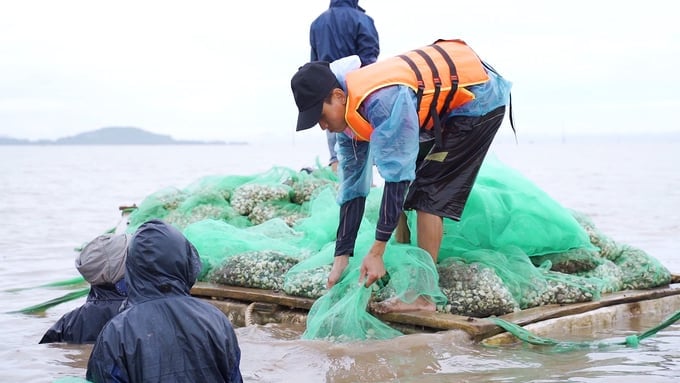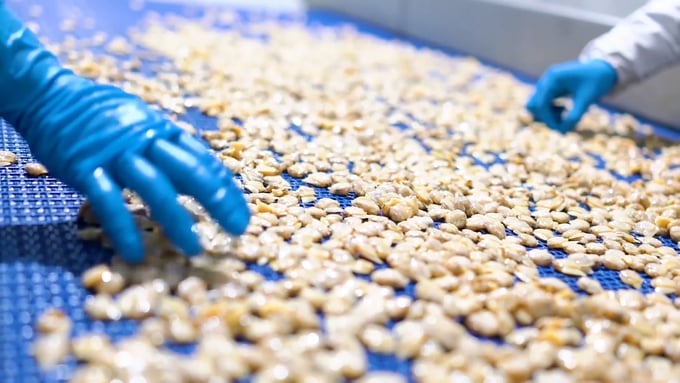May 30, 2025 | 06:30 GMT +7
May 30, 2025 | 06:30 GMT +7
Hotline: 0913.378.918
May 30, 2025 | 06:30 GMT +7
Hotline: 0913.378.918

Vietnam's clam farming industry is encountering various difficulties such as declining resources, unstable seed quality, environmental pollution impacts, and climate change effects. Photo: Quang Dung.
According to the Directorate of Fisheries under the Ministry of Agriculture and Rural Development, mollusk farming is considered one of the key sectors in Vietnam due to its economic value and development potential. Vietnam's main mollusk farming subjects include clams, blood cockles, abalones, scallops, oysters, and mussels.
Additionally, key provinces and cities involved in mollusk farming include Hai Phong, Thai Binh, Nam Dinh, Thanh Hoa, Nghe An, Ha Tinh, Ben Tre, Ca Mau, Tien Giang, Bac Lieu, Tra Vinh, Soc Trang, and Ho Chi Minh city.
The nationwide yield of mollusk farming products was estimated at over 300,000 tons in 2021. Most notably, the total clam farming area was estimated at approximately 15,720 hectares, with an estimated yield of 190,000 tons, resulting in a productivity of 11.82 tons per hectare.
Clam farming and other mollusk farming activities have significantly contributed to the economic development as well as the livelihoods of coastal residents. However, the mollusk farming industry faces various challenges in terms of declining resources, unstable seed quality, environmental pollution impacts, and climate change effects.
Ms. Tong Thi Luong, Head of Aquaculture under Nam Dinh province's Department of Fisheries, reported that local clam farming activities has failed to fully utilize its potential and advantages. Despite the favorable conditions, this industry is confronted with numerous challenges.
"Due to the nature of this occupation being situated in low-lying coastal areas, which are submerged during high tide (also known as intertidal zones), the control of environmental factors can be a challenging task. Furthermore, local farmers rely solely on natural feed sources, with minimal human intervention. Moreover, the industry is affected by significant impacts of climate change, and off-season storms. Most notably, clam farming in the northern regions is subject to salt fog in combination with prolonged high salinity," Ms. Luong noted.
According to Ms. Luong, mass deaths of clams have occured in Nam Dinh and adjacent provinces in the past, inflicting substantial losses on local farmers.
Another challenge lies in the limited product consumption linkage. Local residents mainly consume products on a small scale due to a lack of access to supermarket chains or processing plants. Consequently, local processed products are limited, which further resulted in unstable production values and outlets.
Mr. Nguyen Ho Nguyen, General Director of Lenger Vietnam Seafood Co., corroborated the aforementioned assessment: "Lenger Vietnam encounters numerous challenges in purchasing clams and assisting farmers in the rearing process. Lenger Vietnam procures clams with an emphasis on special standards and techniques. However, the majority of local farmers are unable to meet this requirement. As a result, the company must purchase the entire clam bed and perform selection at the factory."
"On the other hand, there is a decreasing trend in clam seed quality, and the size of clams is slowly shrinking. Both domestic and international markets have a preference for larger clams. Furthermore, the rearing expenses are rising rapidly, especially in terms of seed costs and materials, which consequently raise the production cost, and restrict access to the market."

It is essential to promote deeper processing of clam products, and reduce the product prices and transportation expenses. Photo: Quang Dung.
Mr. Nguyen added, “In response to these challenges, Lenger Vietnam has accompanied and persuaded local farmers to understand the farming and harvesting process for clams, thereby meeting the processing plant's requirements. Moreover, we assist farmers in acquiring ASC certification to meet the increasingly high demands of the global market. The goal is to ensure that clams are farmed safely, sustainably, and responsibly with a focus on the consumer.”
According to Mr. Nguyen, Lenger Vietnam is implementing a high-tech clam seedbed. Accordingly, the company aims to produce adequately-sized clams as required by the international market within the next few years.
“We have also proposed building a model for on-shore clam farming to effectively manage the farming environment, and provide the clams with sufficient nutrition. Additionally, the model will utilize an internationally standardized method of harvesting. We hope that this model will be replicated nationwide, thereby reducing the overall cost of clams. I believe that with on-shore seedbeds and clam farming, we can establish a strong clam farming industry,” stressed Mr. Nguyen.
According to Nam Dinh province's Department of Fisheries, a sustainable clam farming industry and an extensive target market range for Vietnamese clams requires a reorganization of the production process, from farming, processing, to consumption. Consequently, it is essential to promote deeper processing of clam products, and reduce the product prices and transportation expenses. Additionally, special projects, mechanisms, and policies for the development of clam farming and aquaculture as a whole are a necessity.
Mr. Nguyen emphasized, “Many countries around the wolrd, such as the United States, Japan, and even the domestic market prefer larger, meatier clams. This is a barrier to further market access for Vietnamese clams.”
Translated by Nguyen Hai Long
/2025/05/25/4127-3-073637_820.jpg)
(VAN) Thanks to the promotion from an FAO-implemented project, vegetable production in greenhouses in Moc Chau has seen strong development, from 1.5 hectares in 2021 to nearly 50 hectares in 2024.

(VAN) FAO has recently supported USD 140,000 to implement the project 'Risk mitigation human-animal interface risks through disease control initiatives in pig farming.'

(VAN) The People's Committee of Tra Vinh province has approved an adjustment to the investment policy for the Green Hydrogen Plant project, increasing its area to approximately 52.76 hectares.
![Reducing emissions from rice fields: [2] Farmers’ commitment to the soil](https://t.ex-cdn.com/nongnghiepmoitruong.vn/608w/files/news/2025/05/05/dsc08881jpg-nongnghiep-140632.jpg)
(VAN) Clean rice cultivation model in Thuong Tan commune, Bac Tan Uyen district, is assisting local residents in achieving sustainable agriculture by substantially reducing costs, increasing productivity, and protecting the environment.

(VAN) At the conference to disseminate Resolution No. 68, AgriS introduced its digital agricultural ecosystem and reaffirmed its commitment to accompanying the Government in promoting private sector development and sustainable agriculture.

(VAN) 'Blue Ocean - Blue Foods' initiative is designed to restore marine ecosystems and establish sustainable livelihoods for local communities by cultivating a minimum of 1,000 hectares of cottonii seaweed in the first three years.
/2025/05/21/4642-3-112707_603.jpg)
(VAN) The V-SCOPE project has made direct contributions to three out of six pillars of the Comprehensive Strategic Partnership between Vietnam and Australia.